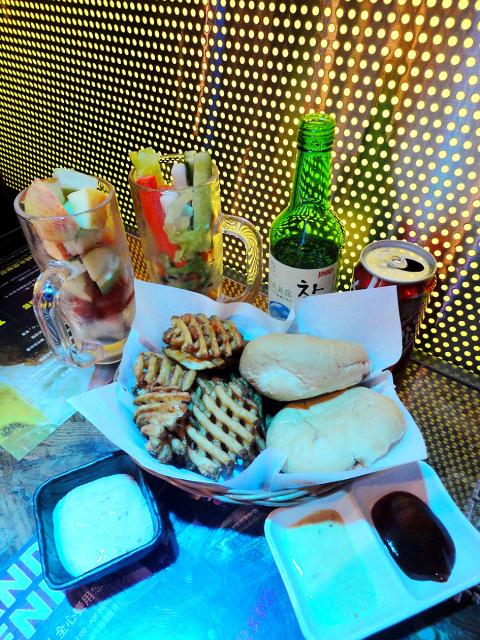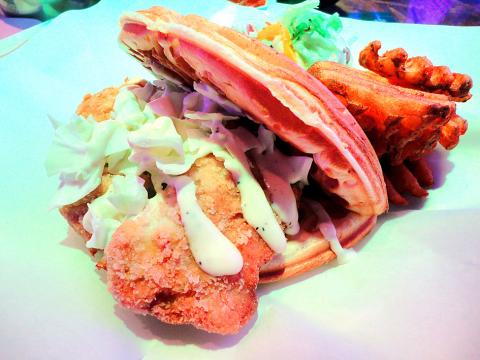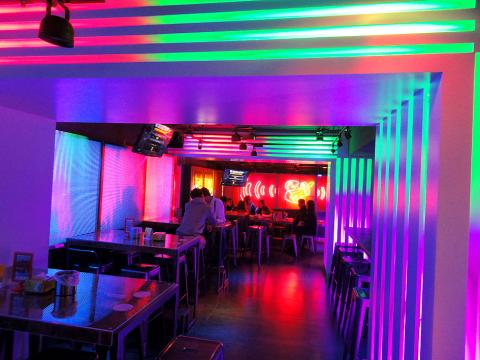East District is the city’s most exuberant area, where you can spot the newest trends in fashion, design, dining and clubbing. A fresh addition to the bustling lanes of Zhongxiao East Road (忠孝東路) screams its presence with dynamic lighting, loud music and a punchy tag line: chicken and beer.
Welcome to TKK The Bar, a new expansion project of the local fast food chain T.K.K. Fried Chicken (頂呱呱).
It’s a gastropub that serves a variety of fried chicken, fries, salads, waffles and alcoholic drinks. Since its grand opening last month, the new endeavor has enjoyed a quick table turnover rate powered by a clientele that is young and hip.

Phopto: Tang Hsiang-yi, Taipei Times
I hadn’t planned to go, but strolling by the glowing box with a friend by chance, I was drawn in by its flashy LED lights.
Just in case the T.K.K. Fried Chicken chain doesn’t ring a bell, it’s a local business founded in the 1970s as an alternative to imported fast food brands like KFC and McDonald’s.
At first glance, TKK The Bar struck me as a brand-new establishment that shares nothing with the chain. The decorative touches of the old-fashioned fast food chain did not make an appearance in this cool, modern-looking bar restaurant.

Photo: Tang Hsiang-yi, Taipei Times
But to my disappointment, the food at TKK The Bar is less impressive than its ambience. The bar menu presents what the fast food chain offers — the usual chicken necks (NT$180), chicken drumsticks (NT$250) and roasted half chicken (NT$349) — with few innovations of its own.
One of the few new items is the fried chicken waffle sandwich (served with a mini salad and waffle fries for NT$210). We ordered the sandwich out of curiosity, and it came just as it sounds: It’s a piece of lemon-flavored chicken chop dressed with morsels of chopped cabbage and sandwiched in a waffle. The citrus flavor of the chicken leaves a zesty aftertaste, but other than that, the dish provided nothing out of the ordinary.
Other items we ordered included the mini pizza buns (an order of two served with assorted fries for NT$180), veggie sticks (NT$80) and an assorted fruit box (NT$100).

Photo: Tang Hsiang-yi, Taipei Times
At T.K.K. Fried Chicken, the mini pizza is my preferred snack — the pocket-sized pizza-in-a-bun warms up a stomach in need of a quick refill. However, having it in a gastropub proved less delightful. Especially when I know one bun costs only NT$45 at the fast food restaurant. The bun at the bar cost more but tasted exactly the same, though it came arranged in a better-looking basket instead of a paper bag.
Both the veggie sticks and fruits came in beer glasses with Thousand Island dipping sauce on the side. The veggies were cucumber, carrot and radish sticks mingled with lettuce and bell pepper slices, while the fruit box comprised morsels of guava, apple and cherry tomatoes. Everything tasted banal.
Still, the merely-average food quality didn’t seem to stop customers from coming, which suggests to me that people don’t go there for the chicken. Instead, TKK The Bar is where friends meet, sit down for a beer and maybe some finger food — even when the volume of dance remixes playing in the bar would definitely prevent diners from having a conversation.
For thirsty diners, the drink menu offers plenty of reasonably-priced options. The selection includes a Taiwanese draft (NT$120), Japanese Kirin draft (NT$150), Thai Singha beer (NT$120) and Korean Hite (NT$120). There’s also a list of Japanese sawa drinks and fun cocktails based on creme de cassis. We picked a bottle of Korean Chamisul Soju (NT$250).
■ Excessive consumption of alcohol can damage your health.

This is the year that the demographic crisis will begin to impact people’s lives. This will create pressures on treatment and hiring of foreigners. Regardless of whatever technological breakthroughs happen, the real value will come from digesting and productively applying existing technologies in new and creative ways. INTRODUCING BASIC SERVICES BREAKDOWNS At some point soon, we will begin to witness a breakdown in basic services. Initially, it will be limited and sporadic, but the frequency and newsworthiness of the incidents will only continue to accelerate dramatically in the coming years. Here in central Taiwan, many basic services are severely understaffed, and

Jan. 5 to Jan. 11 Of the more than 3,000km of sugar railway that once criss-crossed central and southern Taiwan, just 16.1km remain in operation today. By the time Dafydd Fell began photographing the network in earnest in 1994, it was already well past its heyday. The system had been significantly cut back, leaving behind abandoned stations, rusting rolling stock and crumbling facilities. This reduction continued during the five years of his documentation, adding urgency to his task. As passenger services had already ceased by then, Fell had to wait for the sugarcane harvest season each year, which typically ran from

It is a soulful folk song, filled with feeling and history: A love-stricken young man tells God about his hopes and dreams of happiness. Generations of Uighurs, the Turkic ethnic minority in China’s Xinjiang region, have played it at parties and weddings. But today, if they download it, play it or share it online, they risk ending up in prison. Besh pede, a popular Uighur folk ballad, is among dozens of Uighur-language songs that have been deemed “problematic” by Xinjiang authorities, according to a recording of a meeting held by police and other local officials in the historic city of Kashgar in

It’s a good thing that 2025 is over. Yes, I fully expect we will look back on the year with nostalgia, once we have experienced this year and 2027. Traditionally at New Years much discourse is devoted to discussing what happened the previous year. Let’s have a look at what didn’t happen. Many bad things did not happen. The People’s Republic of China (PRC) did not attack Taiwan. We didn’t have a massive, destructive earthquake or drought. We didn’t have a major human pandemic. No widespread unemployment or other destructive social events. Nothing serious was done about Taiwan’s swelling birth rate catastrophe.